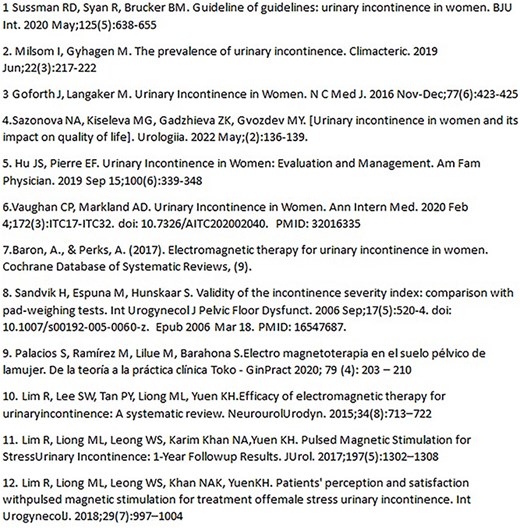-
PDF
- Split View
-
Views
-
Cite
Cite
M ROSSELLÓ BarbarÁ, A R U I Z Cambara, J P O N S Viver, A Teyrouz, M R O S S E L L O Gaya, SAFENESS AND EFICCACY OF THE USE OF FOCAL HIGHELECTROMAGENETIC NO INVASIVE ENERGY FOR FEMALE URINARY INCONTINENCE, The Journal of Sexual Medicine, Volume 22, Issue Supplement_2, May 2025, qdaf077.047, https://doi.org/10.1093/jsxmed/qdaf077.047
Close - Share Icon Share
Abstract
The aim of this study is to investigate the efficacy of electromagnetic chair therapy in the treatment of any type of urinary incontinence, evaluating its impact on perceived efficacy and patient satisfaction.
Cohort study in women with any type of UI, carried out in six centers in different Spanish cities. Participants who had undergone treatment from November 2022 to December 2023 were included.
Eligible patients were women between 18 and 75 years old, with mild or moderate UI according to the Sandvik severity index [8]. All subjects had given written informed consent for treatment.
Women had to be postmenopausal or surgically oophorectomied, or use a medically accepted contraceptive (oral contraceptives, implants, barrier method with spermicide, abstinence), have a normal cervical cytology (Pap smear) during the last year, and have an external vaginal area (vestibule and introitus) free of wounds or bleeding; have a normal vaginal canal for age and no hidden or active infection.
A total of 300 patients were assigned to treatment. 48.98% had stress incontinence, 12.24% had urge incontinence and 38.78% had mixed The mean age (SD) was 54.41 (12.42) years.The mean body mass index was 26.4 kg/m2,. Most patients were menopausal (65.5%).
Peripheral magnetic stimulation or so-called transcutaneous magnetic stimulation (TMS) is a non-invasive method of delivering a high-intensity magnetic field and rapid pulses aimed at the periphery of the body. Interest in research and clinical applications has increased over the past two decades, as it is considered a novel, painless, and easy approach for many neurological and musculoskeletal conditions. (9). The chair that generates an electromagnetic field and triggers the stimulation and toning of the pelvic floor muscles has been shown to have the potential to improve UI.
N.




